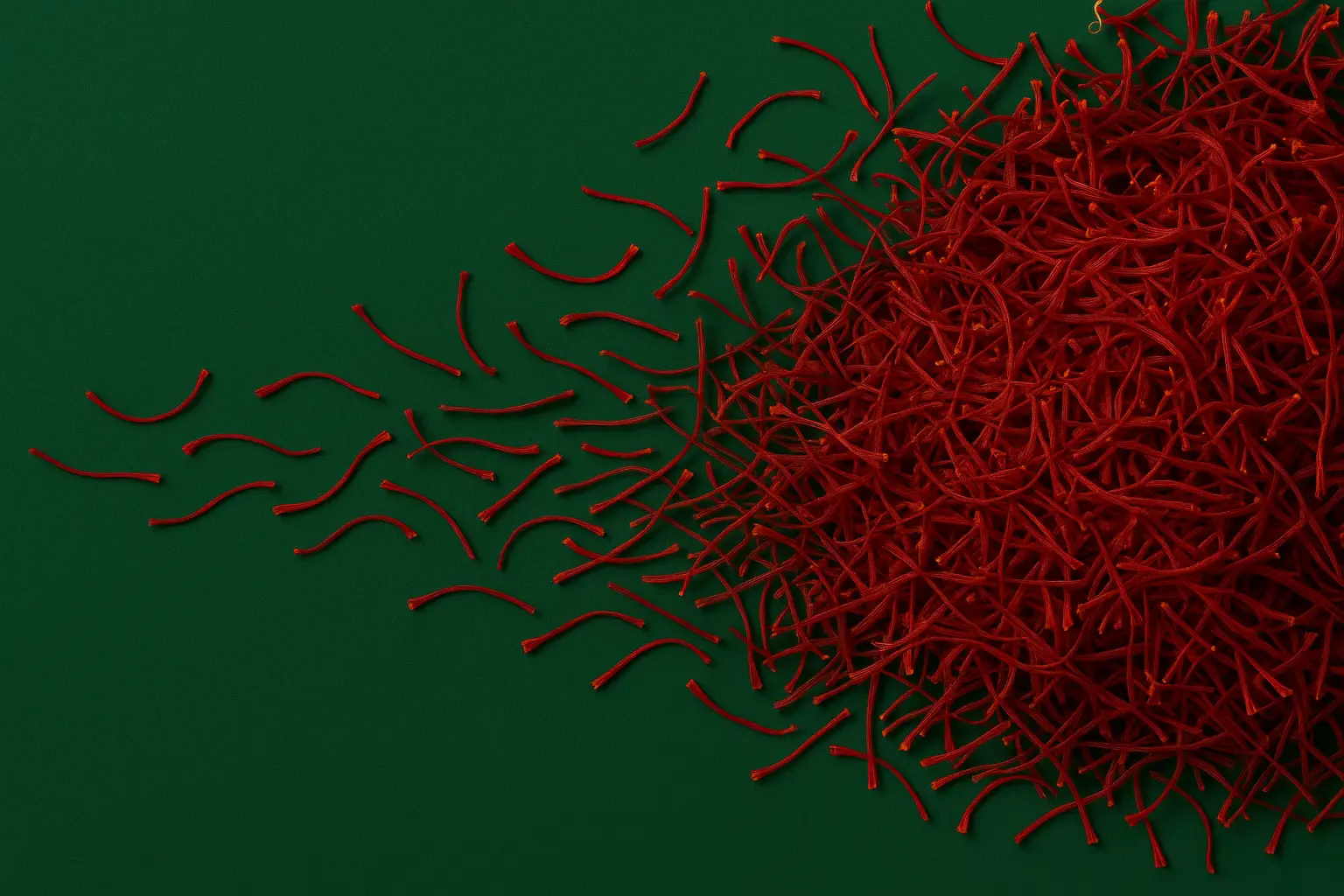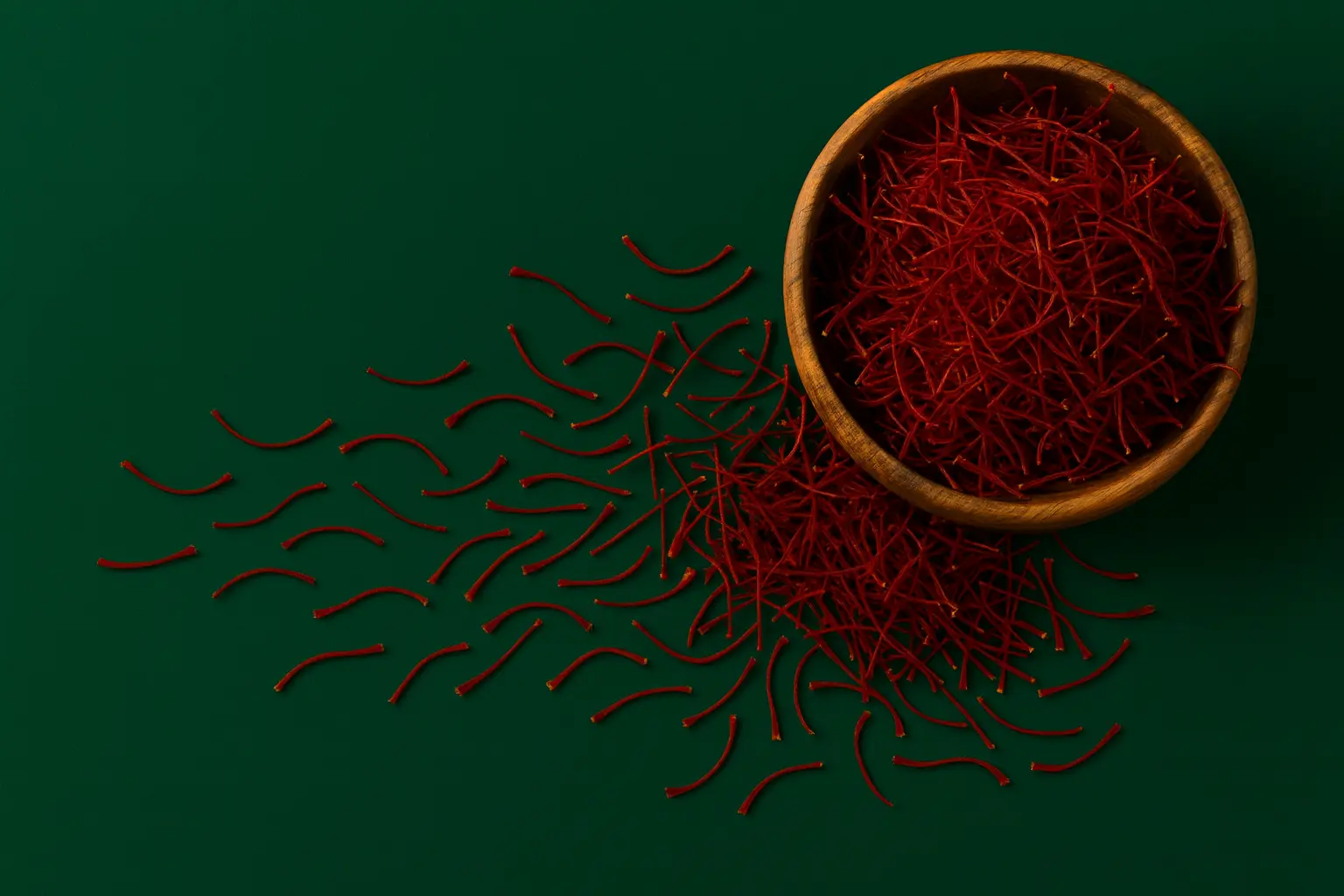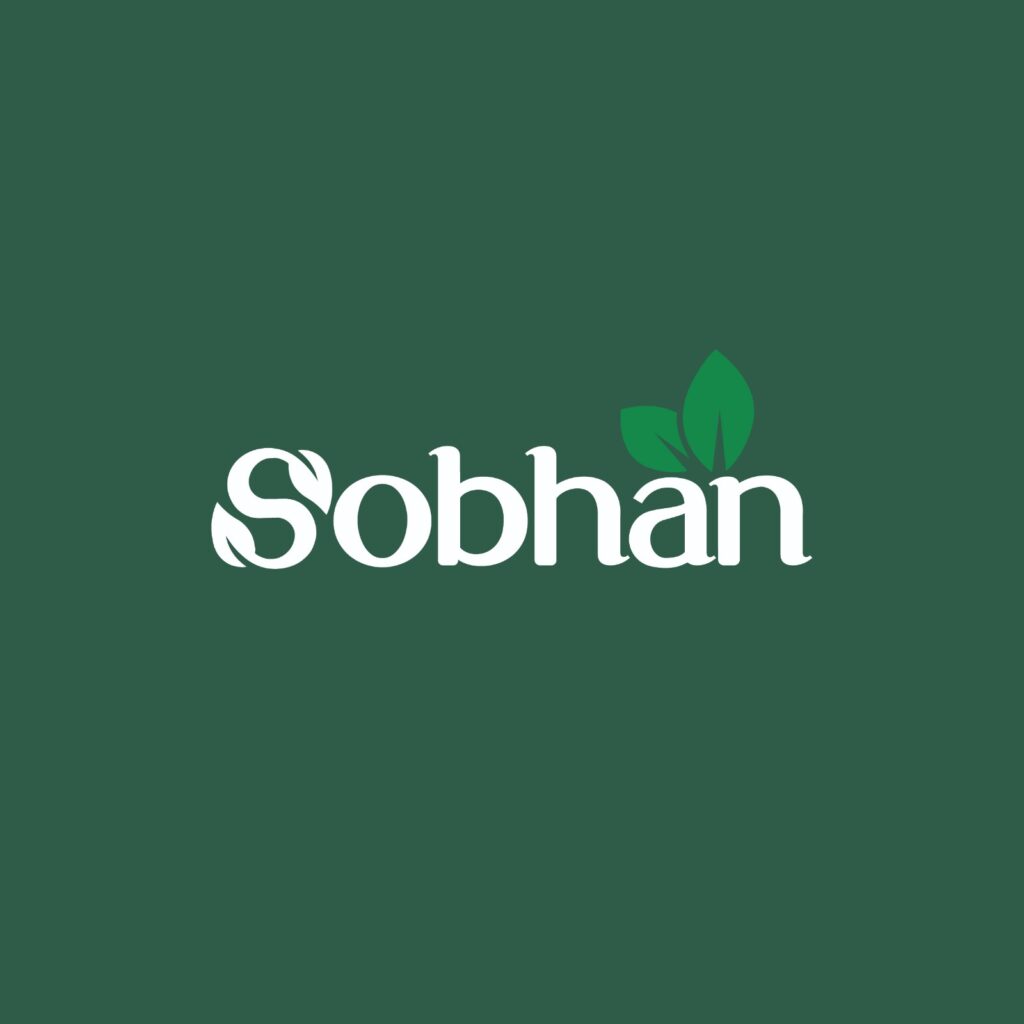Introduction: Why Pure Saffron Is Known as Red Gold
Saffron is not just a spice — it’s a cultural symbol, a luxury ingredient, and one of the world’s most valuable agricultural treasures.
Harvested from the Crocus sativus flower, each saffron thread is a stigma — handpicked one by one, then dried carefully to preserve its natural compounds. It takes around 150,000–170,000 flowers to produce just one kilogram of dried saffron. That means every gram of saffron represents hundreds of hours of careful labor, generations of skill, and deep agricultural heritage.
Iran has been the heart of the saffron world for over 1,000 years, responsible for more than 90% of global production. From the dry climate of Khorasan to the highlands of Kerman, Iranian farmers have perfected cultivation methods that yield saffron of the highest possible quality — rich in color, aroma, and flavor.
But saffron’s incredible value also makes it vulnerable. The global market is flooded with fake, adulterated, or low-grade saffron, sold as “premium” to unsuspecting consumers.
That’s why it’s essential to know how to identify authentic Pure saffron — not just by appearance, but by science.
At SobhanFood, every gram of saffron passes through rigorous testing under ISO 22000, HACCP, and ISO 9001 systems to guarantee purity, safety, and traceability.
Here’s how you can confidently recognize true, high-quality saffron — and ensure every strand you buy is as real as the land it came from.

1. Examine the Color: Deep Red Threads with Golden Tips
Color is the first and most obvious indicator of quality.
Pure saffron threads are deep crimson red and have a slight golden or orange hue at the tips — this natural gradient occurs because each stigma transitions from red at the top to yellow at the base inside the crocus flower.
Key Indicators of Purity:
-
Deep crimson color: Indicates high crocin content.
-
Golden tip: Confirms it’s a full stigma, not a dyed fragment.
-
Natural variation: Every strand is slightly different — uniform color suggests artificial dye.
What to Avoid:
-
Bright red, glossy saffron — likely dyed.
-
Completely uniform threads — machine-colored or synthetic.
-
Brownish saffron — old, oxidized, or poorly stored.
Quick Home Test:
Place a few threads on white paper. Real saffron will not immediately release color. Dyed saffron leaves an instant red or orange stain.
Scientific Insight:
Crocin, the carotenoid responsible for saffron’s golden hue, is stable only when naturally produced. Excessive heat or artificial coloring breaks it down. SobhanFood’s saffron maintains high crocin levels (≥ 200), ensuring long-lasting natural pigment.
2. Smell the Aroma: Complex, Earthy, and Sweet
Saffron’s aroma is one of its most defining qualities. Pure saffron has a sweet, earthy, and slightly metallic fragrance — a sophisticated mix of floral and herbal notes.
The smell comes primarily from safranal, a natural volatile oil that develops when saffron is dried properly.
How to Test:
Gently rub a few threads between your fingers or palms to release the scent.
-
Real Pure saffron: Deep, honey-like aroma with hay or warm soil notes.
-
Fake Pure saffron: Smells like perfume, chemicals, or nothing at all.
Saffron that smells too strong or artificial may have been sprayed with synthetic fragrance.
SobhanFood’s saffron undergoes controlled dehydration at specific temperatures to preserve its safranal levels, resulting in a naturally rich aroma.
Scientific Note:
Safranal concentration decreases when saffron is exposed to light or heat. That’s why SobhanFood uses UV-protected packaging and cold-chain transport to preserve freshness.
3. Taste the Truth: Real Pure Saffron Is Bitter, Not Sweet
Saffron’s flavor often surprises people. Despite its delicate smell, pure saffron tastes bitter, slightly metallic, and earthy.
The bitterness comes from picrocrocin, another natural compound that defines saffron’s flavor profile and contributes to its antioxidant and therapeutic properties.
Test It Yourself:
Put one strand on your tongue.
-
Real saffron: Slightly bitter taste, leaves your tongue dry.
-
Fake saffron: Sweet or flavorless (often coated in sugar or honey).
Some sellers coat fake saffron in sweeteners or oil to add weight and create a false sense of freshness.
SobhanFood saffron is 100% unflavored, with bitterness that indicates natural picrocrocin levels — the sign of purity and freshness.
4. The Water Test: Watch the Patience of Real Pure Saffron
One of the most reliable home methods to test saffron purity is to drop a few strands into a small glass of warm water.
-
Pure saffron: Gradually releases a golden-yellow hue over 10–15 minutes. The threads remain red.
-
Fake saffron: Colors the water bright red or orange immediately, then loses all color as the dye washes away.
Real saffron colors water slowly because crocin dissolves at a steady rate.
Pro Tip:
Smell the water after 15 minutes. Real saffron will release a light honey-like fragrance. Dyed substitutes will have little or no scent.
SobhanFood saffron always displays a gradual color bloom, never an instant stain — proof of its natural purity.
5. Examine the Shape: Trumpet-Shaped Ends and Natural Curves
Saffron’s unique structure is impossible to fully imitate. Each stigma looks like a tiny trumpet — narrow at the base, wider at the top.
Real saffron: Curved or trumpet-shaped, 2–3 cm long, slightly rough texture.
Fake saffron: Flat fibers, straight shapes, or short uneven pieces.
Under a magnifying glass, real saffron threads appear slightly frayed at the tip, while fake saffron looks smooth or uniform.
SobhanFood ensures that every strand remains intact through gentle processing. Our farmers use hand-harvesting techniques that preserve the natural shape of the stigmas — one of the hallmarks of genuine Iranian saffron.
6. The Paper Test: Detect Artificial Coloring
A simple but effective test for detecting dyed saffron is to press the threads between two damp sheets of white tissue paper.
If the paper becomes instantly red or orange, the saffron is artificially dyed.
Pure saffron releases only a faint yellow mark over several seconds.
Artificial colorants like tartrazine or sunset yellow dissolve immediately upon contact with moisture.
SobhanFood’s saffron never stains instantly because it contains no synthetic colorants or coatings — just the natural pigments created by Iran’s climate and soil.
7. Texture and Density: Crisp but Not Brittle
High-quality pure saffron feels dry and crisp — but not fragile. When handled, the threads should not crumble easily or turn to dust.
Poor-quality saffron often feels oily, sticky, or rubbery — a sign of moisture absorption or adulteration.
SobhanFood maintains strict humidity controls (below 12%) to preserve ideal dryness. This ensures the strands snap gently without breaking into powder, extending their shelf life and preserving their compounds.
8. The Milk Test: The Color of Purity
Drop a few threads into a small bowl of warm milk.
-
Real pure saffron: Slowly releases a golden-yellow hue, reaching full strength in about 10 minutes.
-
Fake pure saffron: Instantly turns milk bright red or orange.
Because crocin dissolves slowly, this test perfectly demonstrates the patience of real saffron.
SobhanFood pure saffron, with its exceptionally high crocin index, produces a natural golden color ideal for culinary use — from Persian desserts to European confections.
9. Learn the Grading System: Negin, Sargol, Pushal
Grading helps identify purity and performance.
| Grade | Description | Color Strength (Crocin) | Common Use |
|---|---|---|---|
| Negin | Longest, thickest stigmas, pure red | Extremely high | Premium exports, culinary excellence |
| Sargol | Only top red parts of stigmas | Very high | Domestic and export use |
| Pushal | Red with some yellow style attached | Moderate | Everyday cooking |
| Bunch (Dasteh) | Whole flower stigmas tied together | Variable | Traditional displays |
SobhanFood offers mainly Negin and Sargol, known for their exceptional color intensity and fragrance.
Each batch undergoes ISO 3632 laboratory analysis to confirm crocin (color), picrocrocin (taste), and safranal (aroma) levels before export.
10. Certification and Traceability: The Seal of Trust
Even the best home tests cannot replace professional certification.
That’s why genuine pure saffron producers like SobhanFood guarantee purity through internationally recognized standards.
Certifications to Look For:
-
ISO 22000: Food safety and hygiene compliance.
-
HACCP: Hazard control across all stages of production.
-
ISO 9001: Quality management for consistency and reliability.
SobhanFood’s pure saffron is fully traceable from farm to packaging. Every container is labeled with batch number, origin, harvest year, and QR code for verification.
Always check:
-
Tamper-proof seals
-
Origin label (Iran)
-
Packaging date and expiration date
By choosing a certified brand, you ensure authenticity and quality with every purchase.

Scientific Quality Indicators (ISO 3632 Standards)
Laboratories evaluate saffron by measuring its three main chemical compounds through spectrophotometric testing.
| Compound | Function | Premium Range |
|---|---|---|
| Crocin | Determines color intensity | ≥ 200 |
| Picrocrocin | Creates taste (bitterness) | ≥ 90 |
| Safranal | Defines aroma | 20–50 |
SobhanFood saffron consistently exceeds these benchmarks, ensuring reliable culinary performance and authenticity in every export batch.
Common Types of Fake Saffron
Recognizing common fraud methods helps you avoid buying counterfeit saffron.
-
Dyed Corn Silk: Soaked in color to mimic saffron.
-
Paprika or Marigold Fibers: Similar look but lack aroma.
-
Re-dyed Old Saffron: Restored color, lost potency.
-
Oily or Sugary Coatings: Adds artificial shine and weight.
-
Ground Saffron Powder: Mixed with turmeric or paprika to appear genuine.
SobhanFood sells only whole threads to guarantee verifiable authenticity.
Why Iranian Saffron Is the Global Standard
Iran’s unique geography makes it ideal for saffron cultivation. Warm days, cool nights, and low rainfall create perfect conditions for crocus growth.
The provinces of Khorasan, Kerman, and South Khorasan are particularly famous for producing saffron with the highest crocin levels and strongest aroma profiles.
SobhanFood sources pure saffron directly from these areas, partnering with experienced farmers who combine traditional techniques with modern technology.
This collaboration ensures sustainable production and consistent quality across every season.
SobhanFood’s Commitment to Quality
SobhanFood is dedicated to maintaining Iran’s global reputation for premium pure saffron through innovation, science, and integrity.
Our saffron is:
-
Grown using traditional hand-harvesting methods.
-
Tested in certified laboratories for purity and strength.
-
Processed under HACCP and ISO 22000 safety protocols.
-
Packaged in UV-resistant, airtight containers.
-
Fully traceable through batch coding and export documentation.
Every SobhanFood pure saffron thread represents trust, transparency, and true Iranian heritage.
Storing and Preserving Saffron Quality
Proper storage preserves saffron’s potency.
Best Practices:
-
Store in a cool, dark place.
-
Use airtight glass containers.
-
Avoid exposure to sunlight or humidity.
-
Keep away from strong spices or oils.
SobhanFood’s packaging technology ensures pure saffron retains its full aroma, flavor, and color strength for up to 24 months.
Buying Tips for Consumers and Businesses
-
Always buy whole threads, not powder.
-
Look for certified labels (ISO 22000, HACCP).
-
Check the origin — authentic Iranian pure saffron is clearly marked.
-
Avoid suspiciously cheap saffron.
-
Choose exporters with transparent traceability systems.
SobhanFood provides digital traceability and documentation for international buyers, ensuring each batch is verified and certified at every stage.
The Global Importance of Saffron Purity
The authenticity of saffron affects not only consumers but also farmers, exporters, and the reputation of entire agricultural economies.
Fake saffron harms small-scale farmers who rely on fair trade and diminishes the value of genuine exports.
SobhanFood’s strict certification and transparency contribute to protecting Iran’s pure saffron heritage, ensuring sustainability, fair pricing, and global confidence in Iranian products.
Conclusion: Purity You Can Taste, Trust You Can See
True pure saffron doesn’t rush to impress — it reveals itself slowly, through its fragrance, its color, and its heritage.
When you buy from certified producers like SobhanFood, you’re not just purchasing a spice — you’re supporting generations of Iranian farmers, sustainable agriculture, and a product that carries centuries of tradition.
Real saffron smells natural, tastes bitter, releases color slowly, and comes from trusted, traceable sources.
SobhanFood ensures all of these, delivering saffron that represents purity, passion, and perfection — from Iran to your table.



